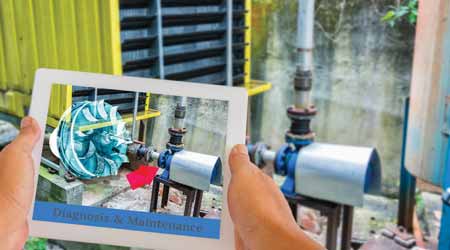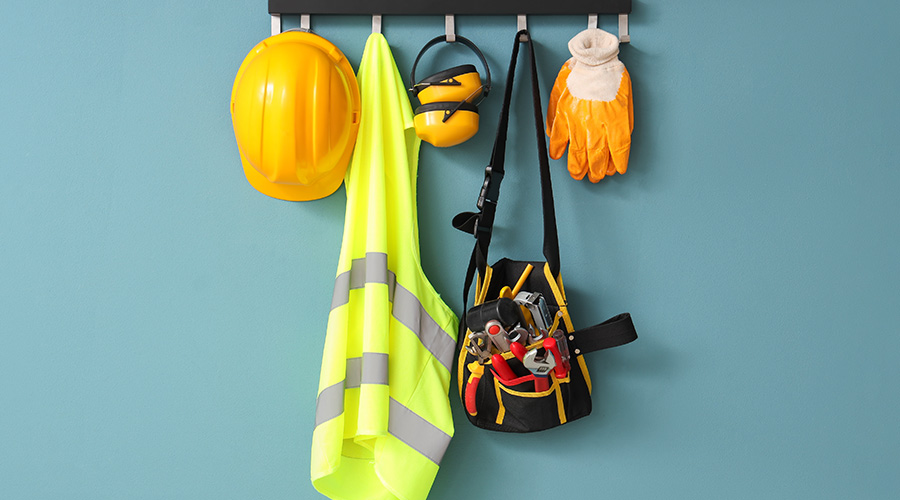 Augmented reality technology could aid equipment maintenance by displaying information about the unit.
Augmented reality technology could aid equipment maintenance by displaying information about the unit.Virtual Reality, Augmented Reality: Better Visualization Aids Operations
VR can be used to eliminate pinch points in design while AR can help FM more easily see the location of specific parts on facility equipment.
Like something out of a childhood dream come true, all you need to access virtual reality is a smartphone and a cardboard box. More sophisticated pairings of hardware and software make immersion in highly detailed virtual environments something readily attainable, and commercial real estate is in the early stages of leveraging the technology, along with its closely correlated counterpart, augmented reality. The design, construction, and leasing sectors have seen the greatest gains, but there is a use case for operations and maintenance that is waiting to take off.
Virtual reality (VR) and augmented reality (AR) are often spoken of in the same breath, but they are two different technologies. Virtual reality puts the viewer in the rendering, as if you’re sticking your head into your computer and looking around. Augmented reality overlays the digital world onto the real world, as in the 2016 Pokémon Go craze.
Virtual reality was developed first and has been embraced by the design and construction communities, in particular during the mockup phase. At HOK, physical mockups are still used, but virtual mockups allow clients to enter the design in a new way. “It helps get beyond the concept of space as rooms and square footage and get into what this space could do, or how they could change it to be a better experience for their staff,” says Daniel Niewoehner, vice president and regional leader of science and technology at HOK. Five years ago, clients would have been walked through the model on a large screen, but the perspective is always a little off in 2D, says Niewoehner. In a few years, he expects the sense of touch to be commonly incorporated into the virtual environment through haptic feedback devices.
In addition to catching the pinch points in a design and easily iterating through design options, virtual reality can be used to incorporate empathy into the built environment, says Niewoehner. The perspective can be changed so that the viewer seems shorter or taller, physical responses can be made slower to mimic aging, or like 10 percent of men the viewer can be made color blind.
Currently, augmented reality’s biggest impact is in existing building renovations or significant upgrades, to “validate design in existing conditions,” says Jordan Moffett, virtual design construction manager at McCarthy. Do you really want upper cabinets in this office? With AR it is possible to see what that looks like in the real space. And it is also being used to catch “design issues that aren’t constructible due to the existing condition,” he says. For example, on one project for a healthcare client, when the new mechanical piping system design was merged into the augmented reality headset for site review, it was discovered that an architectural wall was in the way. The as-built was 12 inches off from reality. “It’s a good example of using pretty inexpensive technology to do something that we used to do with laser scanning and a more time-intensive and costly approach,” Moffett says.
Augmented operations
The use of AR in building operations and maintenance is possible but it’s far from widespread quite yet. “We’ve already started to turn over the HoloLens headset where it’s a deliverable to clients,” says Moffett. (Microsoft calls its HoloLens headset a mixed reality “holographic computer.”) The AR headset comes loaded with the model and all the front-end work of correlating the model to the location, which is the most cumbersome aspect of AR. A facility manager can then go out and walk the building with the model overlayed on reality, knowing exactly where a valve sits, for example, and have immediate access to all the documentation and training materials on it available in their field of vision.
Moffett says as new buildings are built, increasingly, owners and facility managers are starting to ask for the as-built drawings and for models with O&M and warranty information built directly into the model. With models they can trust in future renovations and to help get a better handle on facility management, owners and operators are being more proactive than before. “They’re planning for the future,” he says.
Email comments and questions to naomi.millan@tradepress.com.
Related Topics:


















